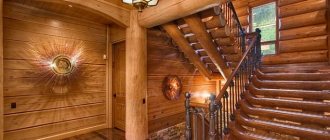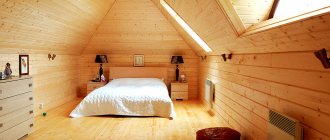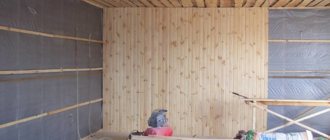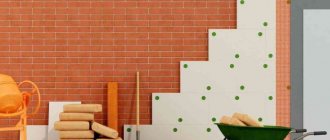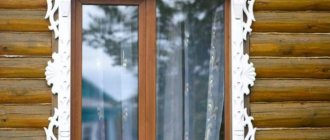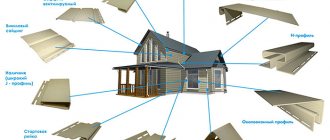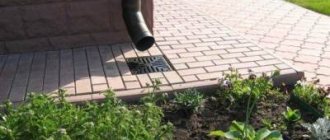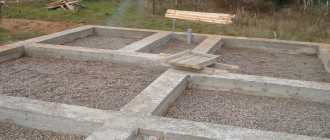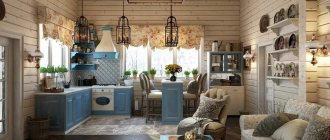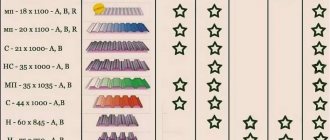Wooden lining is a beautiful, natural material. It is not surprising that so many users around the world prefer it as a finishing and facing material.
The environmental friendliness and natural beauty of wood not only decorates the room, but also creates a certain microclimate in it. And the lining covered with a thick coating (paint, varnish) allows you to create any decor.
But wood has a significant disadvantage that affects the performance characteristics of the lining - it is subject to rotting, various damage, and also tends to darken.
This article is intended for those who want to protect and at the same time preserve the lining in its natural form. Let's consider step by step how and what is the best way to coat (impregnate, treat, paint) wooden lining (euro lining).
I must say that the “take a brush, paint and paint” method is good precisely because of its simplicity. But how long will wood painted this way last? Wouldn't it be better to take a more thorough and correct approach?
Proper painting of wooden lining consists of 4 stages:
Tips for choosing a finishing coating for wooden lining
- color . Since stain or paint changes the color or shade of the lining, you need to use this property. For example, light shades visually increase the space. The use of different colors/shades allows you to zone the room;
- compound . The prefix “bio” after the name of the varnish indicates the absence of harmful substances. This composition can be used for interior work;
- manufacturer . Many domestic analogues of lining varnish or paint can create worthy competition for foreign goods. At the same time, the price of the product will be more humane.
How and with what to paint the lining in the bathhouse and steam room
Wax composition Evrotex-Sauna for lining in a bathhouse Due to the high temperature, it is better not to paint the lining in a bathhouse, but to treat it with protective compounds.
An excellent solution would be to use wax compounds, for example, Evrotex-Sauna. This coating is suitable for use in conditions of high temperature and cyclic intensive humidification.
Advice. You only need to apply the varnish once in the sauna. In the dressing room - you can make several layers.
How and with what to paint the lining on the veranda
The veranda or terrace is exposed to the greatest influence of atmospheric factors, so the material must be resistant. First coat with a layer of primer, and then 2-3 layers of varnish or paint.
How and with what to paint the lining inside/outside the house
There are no particular differences in painting a house outside or inside. The only difference is in the coatings used. Varnish/paint for interior work must meet environmentally friendly requirements. For outdoor work, it is more important that the coating can withstand moisture, temperature changes, and exposure to UV rays. The same type of paint can be used inside and outside a building. The difference is in the number of layers applied.
How to paint lining correctly - tool
To paint the lining you can use:
- brush. They are convenient because they allow you to paint wood in corners and hard-to-reach places. The paint is applied most evenly with a brush;
Advice. To apply the paint with a brush evenly and avoid smudges, you need to immerse the brush halfway in the paint.
- roller Allows you to paint quickly. However, to obtain a uniform layer you need to paint several times;
- spray. Allows you to get the job done as quickly as possible. But it increases paint consumption;
- mitten (chain-shaped). It is convenient to use a glove to paint (impregnate) the places where the lining joins (frames) the pipes;
- foam sponge.
Impregnations
These compositions are distinguished by the fact that they penetrate deep into the structure of the material and do not create a film on the surface. Some of the solutions discussed below can be used as a full-fledged protective layer, others can only be used as preparation for finishing.
The most popular options are:
- Stains give the surface a certain shade, but do not protect it from water and other influences. The compositions can be water-based, alcohol-based or oil-based. They differ in properties, but perform the same function. The choice depends on the specific conditions, but the most popular are water-based solutions; they are distinguished by their low price and safety;
Before covering the lining with stain, you should choose the desired color
- Acrylic-based impregnations are often called glazes. They differ from stains in that they tightly close the pores of the wood, so they can also be used as a finishing finish. If you are thinking about how to cover the lining to prevent it from darkening, then this option will come in handy. Acrylic emulsion reliably protects against ultraviolet radiation, and the surface retains its original color for a long time;
If you are thinking about how to cover the lining outside the house, then choose acrylic compounds with wax, they are especially reliable
- How to cover the lining outside the house or inside the premises to protect them from mold? Antiseptic compounds provide excellent protection against fungus and extend the life of wood significantly. Such solutions are used exclusively as a preparatory layer; the surface is always covered with something again;
Antiseptic impregnations can tint wood to the desired color
- If you are thinking about the best way to coat eurolining in order to increase its resistance to fire, then the best option would be special fire retardant compounds. They also serve as a preparatory layer before the main coat. A universal fire-bioprotective solution can be an excellent solution; it makes the material resistant to both fire and mold.
Universal formulations are very popular
Choose products from well-known manufacturers. You won’t be able to check its quality by eye, so it’s better to consult to find out which formulations have proven themselves best.
Wood paneling painting technology
- Before painting or applying varnish/paint, they must be mixed well. This way they will lie more evenly;
- a test paint will allow you to understand what the painted surface will look like;
- It is better to apply the paint in several thin layers. This way, each layer will dry faster and the coating will be applied more evenly;
- the next layer of paint/varnish should be applied only after the first one has completely dried;
- When painting the lining, you need to leave gaps of 2-3 cm at the top and bottom of the panels. This will allow the tree to breathe. And the gaps themselves can be closed with decorative plinths;
- to avoid obtaining different shades of wood, it is better to paint with paint at a time, using material from one batch;
- if there is a need to interrupt work, try to make sure that the “seam”, the border of the painted and unpainted area, is not in a visible place;
Tips for storing an open can of paint:
If work is interrupted for a long time, then in order to prevent a film from appearing on the surface of the paint, you can put cardboard impregnated with drying oil on the surface.
If a film appears, its particles may fall on the surface to be painted. In this case, it is better to cover the surface with foam rubber and dip the brush through it.
- a more saturated color/shade can be obtained if you apply the paint several times (up to 4). Further increasing the number of layers will have no effect;
- Do not allow paint/varnish to dry too quickly. This may cause the painted layer to crack. Professionals do not recommend applying paint/varnish in direct sunlight.
Lucky
This group of products allows you to create a durable layer on wood that protects the material from moisture. In addition, using varnish you can give the surface the desired shade, or you can use colorless options.
Let's figure out what types of compositions there are:
- Oil-based solutions create a durable protective layer that has good abrasion resistance. They can be used to treat any indoor surface. This option is characterized by low cost and a fairly large assortment of colors;
Oil compositions give the lining a rich color
- If you are thinking about how to cover the lining on the loggia, then pay attention to alkyd varnishes. They adhere very well to the material, give it shine and an even structure and protect it well from moisture;
Alkyd compounds are very popular
- The most environmentally friendly coating for lining inside the house is acrylic-based varnish. They are absolutely safe, odorless and adhere well to wood. An additional advantage can be considered low cost, and the main disadvantage is low abrasion resistance. For this reason, you should not use this composition on surfaces that are frequently touched;
Acrylic compositions are well suited for lining in residential areas
- For those who are deciding how to cover the outside of the lining, it is best to pay attention to polyurethane-based compounds. They have exceptional strength and wear resistance and create a reliable protective layer on the surface. They can also be used inside where you need to give the surface strength and protect it from wear.
Polyurethane compounds are the most reliable
Paints
This type of product differs from the ones described above in that an opaque film is created on the surface. Therefore, if you need to get a specific color, then this option is perfect.
Paint allows you to give the lining any color
There are also many composition options; before covering the lining in the house, you need to choose a specific solution:
- Oil paints are a traditional option that is being used less and less these days. The composition has good protective properties, but it is short-lived; after a year or two, the coating needs to be renewed. Another disadvantage is the small selection of colors;
Oil paints are rarely used
- Alkyd paints are very popular because they adhere very well to the surface and do not lift the fibers of the material. The composition is distributed in a thin layer and forms a durable film that protects well from moisture and has good wear resistance;
This option has a much wider choice of colors.
- Acrylic compositions make it possible to create an attractive and durable coating for eurolining. They are absolutely harmless, which allows them to be used in premises for any purpose. The paints are water-based and come in a huge variety of shades. You can simply buy white composition and pigments and create your own unique color.
Acrylic compositions retain the brightness of colors for a very long time
Preparation
Let's first consider preparing for painting new slats. Ideally, it begins before installation begins. Before you begin finishing, you should sort the purchased material. Boards even from the same batch can vary greatly in texture and quality. Lamels with large defects (lost knots or chips) are set aside for cutting. They will be used for sheathing over windows, doors and other places where short boards are needed.
Next, according to the technology, is exposure in the room where the surfaces are supposed to be sewn up. For several days, the lining must be kept at the same humidity and temperature at which it will be used. Conventionally, this stage is called drying.
After sorting and drying, defects are removed. In addition to large flaws that will have to be cut out, there are a number of minor flaws that can be dealt with. Roughness and burrs are smoothed out with light-grain sandpaper. Traces of fat or resin are removed with a cloth soaked in a 25% acetone solution. Blue stains, white spots and darkening of wood are eliminated by treating with lightening compounds. Next comes treatment with an antiseptic. If the boards have already been processed during production, then, naturally, we skip this stage. In particular, all eurolining is impregnated with an antifungal compound during production.
Processing of lining inside the house is often required for material that has already been put into operation. The need arises if the appearance of the old coating has lost its attractive appearance. Paint has peeled or faded, or oil or grease stains have appeared. Or there was a desire to change the design of the room. In these cases, preparation for painting is also carried out.
It starts with removing the old coating. This operation is performed either purely mechanically or using chemical compounds. If you plan to coat the wood with opaque compounds, you may not remove the old coating. It will be enough to sand it for better adhesion to the new paint. Naturally, this requires that the existing coating does not peel off from the surface of the lining.
The mechanical cleaning method is used, for the most part, to remove oil paint. To do this, use sandpaper, metal brushes, spatulas and scrapers. Heating with a hairdryer will help make the process easier. The paint softened in this way will be relatively easy to remove with a spatula.
Fallen knots, chips and dents are removed with wood putty. It is recommended to clean the wood mechanically, without the use of special compounds, for subsequent application of transparent varnish, since after using chemical removers, the color of the boards may be uneven.
Chemical compositions for cleaning wood are synthetic solvents and softeners. They are used to peel off paint, wash out old wood coatings, and discolor or bleach boards. Please note that special formulations require compliance with safety measures when handling them.
Before starting work, carefully read the instructions for use. After chemical cleaning, wipe the surface with a damp cloth and then with white spirit.
